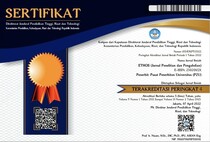Kestabilan Lereng Tambang Batubara dengan Pendekatan Baru Metode Empirik Klasifikasi Massa Batuan
Abstract
Abstract. Rock mass classification is one of the empirical methods for slope stability analysis approach. Rock mass clasification systems that have been developed such as RSR “Rock Structur Rating” (Wickham et al., 1972), RMR “Rock Mass Rating” (Bienieawski, 1973, 1975, 1979, 1989), NGI Q-system (Barton et al., 1974) and the results of the development of the new "Rock Mass Clasification on Rock Slope Stability Assessment" (Ya-Ching Liu, Chao-Shi Chen, 2007) is a combination of the Analytical Hierarchy Process (AHP, Saaty, 1980) and Fuzzy systems. Delphi Method (FDM, Kaufmann and Gupta, 1988) this system consists of 3 grouping factors to assume slope stability consisting of geological, geometrical and environmental factors and the method developed by Ya-Ching Liu, Chao-Shi Chen, 2007 will be used in research this. The observation location used to use this method is spread over 7 mining blocks, namely block 67 - 73 which produces 2 classification characteristics of rock mass which are stable and tend to be unstable.
Abstrak. Klasifikasi massa batuan merupakan salah satu metode empirik untuk pendekatan analisis kestabilan lereng. sistem pengelompokan batuan (Rock mass clasification) yang telah dikembangkan seperti RSR “Rock Structur Rating” (Wickham et al., 1972), RMR “Rock Mass Rating” (Bienieawski, 1973, 1975, 1979, 1989), NGI Q-system (Barton et al., 1974) dan hasil pengembangan yang baru “Rock Mass Clasification on Rock Slope Stability Assessment” (Ya-Ching Liu, Chao-Shi Chen, 2007) merupakan kombinasi sistem Analitytic Hierarchy Process (AHP, saaty, 1980) dan Fuzzy Delphi Method (FDM, Kaufmann and Gupta, 1988) sistem ini terdiri dari 3 faktor penglompokan untuk mengasumsikan kestabilan lereng terdiri dari faktor geologi, geometri dan lingkungan dan metode yang dikembangkan oleh Ya-Ching Liu, Chao-Shi Chen, 2007 akan digunakan dalam penelitian ini. Lokasi pengamatan yang digunakan untuk menggunakan metode ini tersebar pada 7 blok penambangan yaitu blok 67 – 73 yang menghasilkan 2 karakteristik klasifikasi massa batuan yaitu stabil dan cenderung tidak stabil.
Keywords
Full Text:
PDFReferences
Barton, N., Lien, R., Lunde, J., (1974). Engineering Classification Of Rock Masses For The Design Of Tunnel Support. Rock Mechanics 6 (4), 189-236.
Bieniawski, Z. T. (1973). Engineering Classification Of Jointed Rock Masses, Transactions Of The South African Institution Of Civil Engineer 15 (12), 335-344 : Wiley.
Bieniawski, Z. T. (1975). Case Studies : Predictions Of Rock Mass Behaviour by The Geomechanics Classification, Brisban, 36 - 41.
Bieniawski, Z. T. (1979). The Geomenchanics Classification In Rock Engineering Application., ISRM, Vol 2, 41 – 48.
Bieniawski, Z. T. (1989). Engineering Rock Mass Classification, Canada : Wiley.
Liu, Y. C., Chen, C.S., (2007). A New Approach For Application Of Rock Mass Classification On Rock Slope Stability Assessment. Engineering Geology 89, 129 – 143.
DOI: https://doi.org/10.29313/ethos.v7i2.4708
Refbacks
- There are currently no refbacks.
Alamat Redaksi:
LPPM Unisba, Lantai 2, Jl. Purnawarman 63, Bandung 40116, Jawa Barat, (022) 4203368 , (022) 4264064. ethos.unisba@gmail.com / ethos@unisba.ac.id

This work is licensed under a Creative Commons Attribution-NonCommercial-ShareAlike 4.0 International License.















